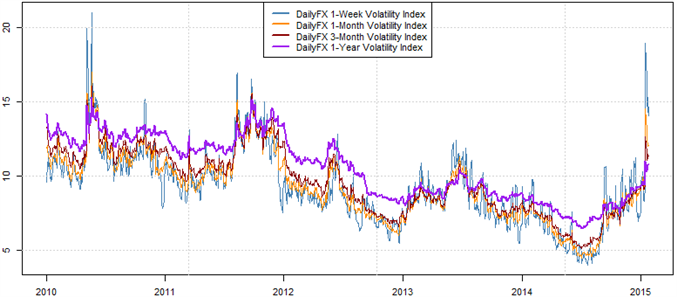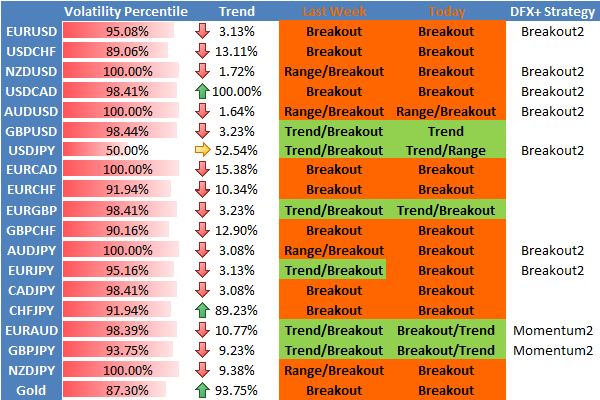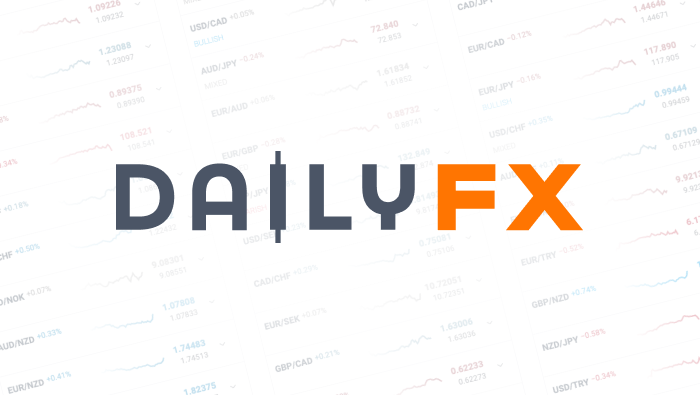- US Dollar at elevated risk of volatility ahead of critical US Federal Reserve decision
- Forex volatility prices continue to trade near multi-year highs amid central bank activity
- We continue to favor high-volatility strategies, but important to limit leverage used
A surge in forex volatility prices suggests big moves are likely in the days ahead. What are the risks and how might we trade?
Currencies have seen sharp price moves in recent weeks, and the coming week may prove no different as markets look to the highly-anticipated US Federal Open Market Committee (FOMC) policy decision. Indeed our DailyFX Volatility indices, which measure prices paid/received on FX options across major pairs, point to sharp moves across the board.
Forex Volatility Prices Remain Near Multi-Year Peaks Ahead of Critical Week

Data source: Bloomberg, DailyFX Calculations
Elevated Euro/US Dollar volatility prices are of particular interest as the pair trades near major decade-plus lows. Current 1-week EURUSD volatility data implies that the currency pair is likely to move in as much as a +/- 250 point range in the coming seven days. Given heavily stretched price momentum and trader positioning, risks of an important reversal seem particularly high.
Past performance is NOT indicative of future results, but our Breakout2 trading system has done fairly well across US Dollar, Euro, and Japanese Yen pairs through recent price action. There is reason to believe that this system may continue to do well, but it is critical to note that volatility can also make for outsized losses.
It will be critical to keep trading leverage low in what promises to be a big week for FX markets ahead.
DailyFX Individual Currency Pair Conditions and Trading Strategy Bias

Automate our SSI-based trading strategies via Mirror Trader free of charge
--- Written by David Rodriguez, Quantitative Strategist for DailyFX.com
To receive the Speculative Sentiment Index and other reports from this author via e-mail, sign up to David’s e-mail distribution list via this link.
Contact David via Twitter at http://www.twitter.com/DRodriguezFX
Definitions
Volatility Percentile – The higher the number, the more likely we are to see strong movements in price. This number tells us where current implied volatility levels stand in relation to the past 90 days of trading. We have found that implied volatilities tend to remain very high or very low for extended periods of time. As such, it is helpful to know where the current implied volatility level stands in relation to its medium-term range.
Trend – This indicator measures trend intensity by telling us where price stands in relation to its 90 trading-day range. A very low number tells us that price is currently at or near 90-day lows, while a higher number tells us that we are near the highs. A value at or near 50 percent tells us that we are at the middle of the currency pair’s 90-day range.
Range High – 90-day closing high.
Range Low – 90-day closing low.
Last – Current market price.
Bias – Based on the above criteria, we assign the more likely profitable strategy for any given currency pair. A highly volatile currency pair (Volatility Percentile very high) suggests that we should look to use Breakout strategies. More moderate volatility levels and strong Trend values make Momentum trades more attractive, while the lowest Vol Percentile and Trend indicator figures make Range Trading the more attractive strategy.
HYPOTHETICAL PERFORMANCE RESULTS HAVE MANY INHERENT LIMITATIONS, SOME OF WHICH ARE DESCRIBED BELOW. NO REPRESENTATION IS BEING MADE THAT ANY ACCOUNT WILL OR IS LIKELY TO ACHIEVE PROFITS OR LOSSES SIMILAR TO THOSE SHOWN. IN FACT, THERE ARE FREQUENTLY SHARP DIFFERENCES BETWEEN HYPOTHETICAL PERFORMANCE RESULTS AND THE ACTUAL RESULTS SUBSEQUENTLY ACHIEVED BY ANY PARTICULAR TRADING PROGRAM.
ONE OF THE LIMITATIONS OF HYPOTHETICAL PERFORMANCE RESULTS IS THAT THEY ARE GENERALLY PREPARED WITH THE BENEFIT OF HINDSIGHT. IN ADDITION, HYPOTHETICAL TRADING DOES NOT INVOLVE FINANCIAL RISK, AND NO HYPOTHETICAL TRADING RECORD CAN COMPLETELY ACCOUNT FOR THE IMPACT OF FINANCIAL RISK IN ACTUAL TRADING. FOR EXAMPLE, THE ABILITY TO WITHSTAND LOSSES OR TO ADHERE TO A PARTICULAR TRADING PROGRAM IN SPITE OF TRADING LOSSES IS MATERIAL POINTS WHICH CAN ALSO ADVERSELY AFFECT ACTUAL TRADING RESULTS. THERE ARE NUMEROUS OTHER FACTORS RELATED TO THE MARKETS IN GENERAL OR TO THE IMPLEMENTATION.
OF ANY SPECIFIC TRADING PROGRAM WHICH CANNOT BE FULLY ACCOUNTED FOR IN THE PREPARATION OF HYPOTHETICAL PERFORMANCE RESULTS AND ALL OF WHICH CAN ADVERSELY AFFECT ACTUAL TRADING RESULTS.
Any opinions, news, research, analyses, prices, or other information contained on this website is provided as general market commentary, and does not constitute investment advice. The FXCM group will not accept liability for any loss or damage, including without limitation to, any loss of profit, which may arise directly or indirectly from use of or reliance contained in the trading signals, or in any accompanying chart analyses.





